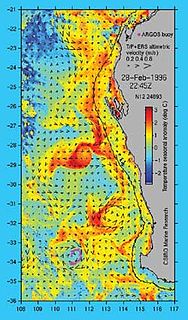
The Houtman Abrolhos is a chain of 122 islands, and associated coral reefs, in the Indian Ocean off the west coast of Australia, about eighty kilometres (50 mi) west of Geraldton, Western Australia. It is the southernmost true coral reef in the Indian Ocean, and one of the highest latitude reef systems in the world. It is one of the world's most important seabird breeding sites, and is the centre of Western Australia's largest single-species fishery, the western rock lobster fishery. It has a small seasonal population of fishermen, and a limited number of tourists are permitted for day trips, but most of the land area is off limits as conservation habitat. It is well known as the site of numerous shipwrecks, the most famous being the Dutch ships Batavia, which was wrecked in 1629, and Zeewijk, wrecked in 1727.

Panulirus cygnus is a species of spiny lobster, found off the west coast of Australia. Panulirus cygnus is the basis of Australia's most valuable fishery, making up 20% of value of Australia's total fishing industry, and is identified as the western rock lobster.

The Leeuwin Current is a warm ocean current which flows southwards near the western coast of Australia. It rounds Cape Leeuwin to enter the waters south of Australia where its influence extends as far as Tasmania.

North Island is the northernmost island in the Houtman Abrolhos, a coral reef archipelago in the Indian Ocean off the coast of Mid West Western Australia. Located about 14 km (9 mi) from the nearest island group, it is one of the largest islands in the Houtman Abrolhos, and one of the few to support dune systems. It has relatively diverse flora dominated by chenopod shrubs and fauna that includes the introduced tammar wallaby, around seven species of reptile, and about 15 resident bird species.

Batavia Road was a passenger boat used from 1946 for commercial tourist operation in the Houtman Abrolhos, a group of islands off the coast of Western Australia.

The Abrolhos painted buttonquail is a subspecies of the painted buttonquail endemic to the Houtman Abrolhos. It is common on North Island, and also occurs on other islands of the Wallabi Group, namely East Wallabi, West Wallabi, Seagull and Pigeon Islands.
The Percy Sladen Trust Expeditions to the Abrolhos Islands were two scientific expeditions, conducted in 1913 and 1915 under the leadership of Professor William John Dakin and funded by the Percy Sladen Trust. These expeditions conducted extensive research into the natural history of the Houtman Abrolhos, an archipelago in the Indian Ocean off the coast of Western Australia.

East Wallabi Island is an island in the Wallabi Group of the Houtman Abrolhos, located in the Indian Ocean off the west coast of mainland Australia.

Elysia tomentosa is a species of sacoglossan sea slug, a shell-less marine opisthobranch gastropod mollusk in the family Plakobranchidae.
Acanthophora spicifera is a species of marine red algae in the family Rhodomelaceae.
Acropora abrolhosensis is a species of acroporid coral that was first described by John Veron in 1985. Found in sheltered lagoons and shallow reefs, it is listed as a vulnerable species on the IUCN Red List. The population of the species is decreasing, and most specimens are found in Western Australia, but occurs in many other areas. It is also listed under CITES Appendix II.

Beacon Island, also known as Batavia's graveyard, is an island on the eastern side of the Wallabi Group at the northern end of the Houtman Abrolhos, in the Indian Ocean, off the coast of Western Australia.

Kyphosus cornelii, the Western buffalo bream, Cornel's drummer or the Western drummer, is a species of marine ray-finned fish, a sea chub belonging to the family Kyphosidae. It is endemic to Western Australia.









